Coalition and Iraqi Strikes on ISIS Remnants
Iraqi Ministry of Defense released a video confirming ongoing efforts to destroy Islamic State hideouts in Iraq
Coalition and Iraqi Strikes on ISIS Remnants

BANNER: (Source: وزارة الدفاع العراقية/archive, background; The Baghdad Post/archive, top left)
Despite U.S. President Donald Trump’s claims of victory against the Islamic State of Iraq and Syria (ISIS) caliphate in 2018, its remnants remain active in Syria and Iraq.
ISIS militants have exploited the chaos amid the Syrian conflict to hold onto their positions for years. Throughout 2018, the DFRLab reported on the decline of ISIS forces as the militants gradually forfeited territory. Meanwhile in Iraq, the U.S.-led international coalition, together with the Iraqi military, has waged a successful war against the militants. In 2019, ISIS’s territorial control in Iraq was reduced to virtually zero.
Despite the decrease of the size of their controlled territory, ISIS continues to operate in small groups in remote locations throughout Iraq. While open-source evidence of ongoing anti-terrorist operations is usually difficult to obtain, a video released by the Iraqi Ministry of Defense (MoD) shows Iraqi military and coalition forces conducting strikes on suspected ISIS hideouts, confirming that operations to destroy these remaining pockets of ISIS activity in the region are underway.
Coalition and Iraqi Efforts Against ISIS
The fight against ISIS at the current stage is mostly conducted by the Iraqi Security Forces (ISF), supported by coalition airstrikes and other forms of indirect fire. As ISIS militants seek refuge in difficult terrain, such as mountain ridges and underground tunnels, airstrikes are often the most efficient way to fight against them. Different cases of airstrike use against ISIS forces were reported earlier by various media outlets and government channels. Videos and images from the operations, however, are seldom released.
On February 3, 2019, the Iraqi MoD released a video showing alleged airstrikes on ISIS positions in Iraq. The DFRLab could not identify the precise nature of the targets, however, because the video lacked sufficient detail. Nonetheless, the location of the targets were geolocated to be in the territory of Iraq.
The published video contained scarce geolocation information, complicating the geolocation process. As no other videos or photos of the operation were released, the DFRLab could not corroborate the geolocation results from any other source. The DFRLab, however, verified the locations from the lone video and concluded that the strikes took place in the northern part of Iraq. Some independent online researchers provided possible locations of the strikes, allowing the DFRLab to verify some of the areas recorded in the video. The white letter ’N’ indicating the direction of north, a common feature in airstrike videos, helped to verify the locations.

The DFRLab confirmed two potential locations in remote areas in northern Iraq. Both locations appeared to be difficult-to-access mountainous areas, ideal for militant hideouts.

The DFRLab added the locations an interactive map to visualize their spread throughout the region.
The DFRLab also compared this map to Februaury 3 data from LiveUAMap. As LiveUMap tracks daily the territorial gains and losses of different factions of the conflict, the data revealed whether or not the strikes took place in ISIS-controlled territory (marked in black).

According to the data, both strikes took place outside of the ISIS-controlled area in the northern part of Iraq. This area, at the time of the video release, was controlled by the Iraqi government, which suggests that the claims of ISIS militants possessing hideouts throughout Iraqi government-controlled territory are likely true.
Conclusion
Despite Donald Trump’s announcement of victory against the ISIS caliphate, the fight against the militants in Syria and Iraq continues. As the militants gradually lost territorial control throughout recent years, a large majority of them dispersed throughout government-controlled areas in Iraq, waging their war from there.
These hideouts are usually established in difficult-to-access areas or in underground tunnels, making it difficult for regular forces to locate and eliminate them through direct fire. Iraqi military forces, in cooperation with the U.S.-led coalition, destroy such hideouts using indirect fire. The paucity of open-source information on these operations precludes precise estimates of their scope; nonetheless, occasional videos, such as the one released by the Iraqi MoD on February 3, confirm that efforts to eliminate the remaining pockets of ISIS militants throughout Syria and Iraq are active and ongoing.
The DFRLab will continue to monitor ISIS militant operations and military developments in both Syria and Iraq.
Follow along for more in-depth analysis from our #DigitalSherlocks.

